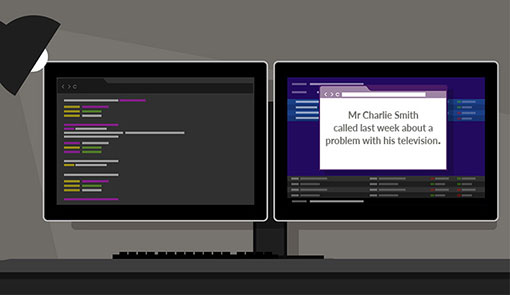We present 50 great ideas that will hopefully help you to improve your customer service.
Ideas to Help You Improve Your Customer Service
1. Make Use of Regional Accents
It’s possible to route calls to a person who is more connected with a particular region.

For example, you could route calls from the 0191 STD code to an agent who is a Geordie (even if they are now working in Cardiff!).
This clever call centre routing technique can be a very effective method for building rapport with customers.
For more clever call routing strategies, read our article: The Top 10 Call Routing Strategies
2. Find Out Why Customers Are Leaving You
You probably have customers leaving you every day. But have you ever gone through their call history to find out why?

It can provide a fascinating insight.
Here’s an exercise: Identify 10 customers who have recently left your company. Go through their contact histories and listen to their calls to the contact centre. See if you can identify some reasons why they may be leaving. See if you can identify some clues earlier in their interactions about their future intents.
Now, this is not a straightforward exercise and it is not always easy to pinpoint why people are leaving. It also may be for reasons out of your control, such as pricing.
3. Familiarize Your Agents With Your Website and Mobile Apps
All of your agents should be familiar with your company website so that they can refer to it during a call or answer any general questions a customer may have about where to find certain information. The same applies to your mobile app.

An in-depth knowledge is especially important for utility companies or local councils, where an agent may need to talk a customer through an online payment process.
You could also get your teams to quality check the website content to make sure that it is up to date.
4. Cut Out the Jargon
If you want to simplify communication with your customers, cut out the jargon.

While a certain level of jargon is unavoidable (e.g. for product names like ISAs or for government regulations), it generally gets in the way of clear communication.
A good way to cut out jargon is to add jargon words onto the call-scoring sheets. You then take off a couple of points for every piece of jargon.
But it may not be just the advisors who speak jargon. At one call centre I heard about, whenever somebody spoke in jargon, the call centre manager replied to them in French!
Find the meaning to some classic contact centre jargon by reading our article: Contact Centre Jargon and Terminologies
5. Get Your Team Leaders to “Run Their Own Business”
A great way to engage your team leaders in improving the performance of their agents is to pitch them against each other in “running a business”.

Each team leader starts with a fixed sum of Monopoly money. They can then “earn” money by meeting (and exceeding) their weekly targets, as well as “lose” money for failing to meet targets and generating customer complaints.
Seeing the consequences of underperformance on a small scale can help them to understand the role they play in the overall performance of the real business.
It should also have a positive impact on motivating agents in the short term, as the team leaders pull out all the stops to beat their rivals.
6. Send Your Best Calls to Upper Management
Here is an idea to help share best practice as well as highlight the importance of the contact centre to upper management.

Pick the best call of the week and email it out for everyone in the business to listen to – including your management team. These calls could also be loaded on to the company’s intranet for reference.
To boost the initiative even further, you could ask your CEO to personally congratulate the agent who made the winning call.
7. Turbo Charge Your Knowledge Base
Start by mining your emails to uncover FAQs.

If you look on an average company’s website you will typically see only a small number of frequently asked questions (FAQs). And many of these are blindingly obvious. You know – the sorts of questions that Marketing dream up. And it’s usually not much better in the company’s support knowledge base.
But in your technical support email trails you probably already have a massive gold mine of real customer correspondence on real frequently asked questions (and less frequently asked questions).
So here’s the tip. Get together a “hit team”, collate these problems and drop them into a large document (Google Docs could work as well). You need to put in one email correspondence per page and give each a unique reference.
I would suggest that you start with just 100 emails. Print them all out and get your team to categorize them into up to a dozen piles. You then edit out the duplicates and edit down to the most popular ones. You can then put the edited answers into the knowledge base.
You will find that most of your team will find it a lot easier to edit and check existing words than they will to create new ones.
To find out more about knowledge bases and how to bolster them, read our article: An Introduction to Call Centre Knowledge Base Software
8. Screen Pop Your Calls
Link your technology together so that when a call arrives in your contact centre the customer’s details are “popped” up on the computer screen.

This uses a technology called CTI (Computer Telephony Integration).
[This is not a new tip. In fact, I have been proposing this since 1989.]
In the past, this has been expensive to integrate, but costs have fallen dramatically in the past few years, particularly as a result of cloud contact centre technology.
The details “popped” on the screen can be built based on the telephone number of the caller (the CLI or Calling Line Identity) or on the phone number that they called into, or on the option that they provided in the IVR system.
This helps to reduce the time that it takes to validate a caller, as well as increase the accuracy of phone numbers entered into your database.
Despite this being a well-proven technology and relatively cheap, there are still a large number of contact centres not doing it.
9. Understand What Your Customers Dislike
Here’s a simple exercise. Ask a handful of people in the contact centre what customers dislike.

They will probably come up with a list that looks like this:
- Overseas contact centres (unless they are in the travel industry)
- Touchtone menus
- Long queues
- Repetitive music on hold
- Advisors who know less about the subject than they do
- Speech recognition systems
- Jargon
Once you have got a list like this, prioritize it and start eliminating these from your organization.
By removing the things that customers don’t like, you will find that you will instantly improve customer experience.
10. Ask Customers if They’d Mind Completing a Longer Survey
Here is an idea to help you gather more detailed feedback from the customers who have the time to offer it.

It is widely recommended that a standard customer survey include no more than 3–5 questions. However, some customers may be willing to answer more if you are polite enough to ask.
Creating break points in your survey, where you ask customers if they would like to answer another 5 questions, can help you to gather additional information without frustrating your customers with a “never ending” survey.
11. Avoid F Is for Photo
Be careful with the way that agents spell out words phonetically.

It’s clearest for everyone if during induction you train all advisors on the proper phonetic alphabet – A for Alpha, B for Bravo, etc.
If you don’t, you will find all sorts of “unofficial” phonetic alphabets coming into use.
While S is for Sugar may be fine, M is for Mickey could easily be confused with N is for Nicky. Even worse is the F is for Photo, which I recently heard.
For reference, here is the official Nato phonetic alphabet.
A Alpha
B Bravo
C Charlie
D Delta
E Echo
F Foxtrot
G Golf
H Hotel
I India
J Juliet
K Kilo
L Lima
M Mike
N November
O Oscar
P Papa
Q Quebec
R Romeo
S Sierra
T Tango
U Uniform
V Victor
W Whiskey
X X-ray
Y Yankee
Z Zulu
This should be taught to all advisors during induction. It can also be useful for refresher training sessions.
To find out more about how you can improve customer service by using the phonetic alphabet, read our article: The Phonetic Alphabet – A Simple Way to Improve Customer Service
12. Don’t Start by Asking for the Customer Number
It’s a common contact centre mistake to ask the customer for their customer number at the very start of the phone call.

The problem is that the moment that we start typing this in, the tendency is to stop listening to what the customer is saying. We could easily miss key information that the customer is telling you.
So next time, why not listen to the customer’s problem?
Only once we understand the problem, ask for the customer number.
13. Dazzle and Delight the Customer
Sometimes we need to start thinking beyond the hygiene factors of answering the phone quickly or reducing customer effort.

Wouldn’t it be an awful lot more fun to look at how we can dazzle and delight the customer?
Wouldn’t it be nice to flag up a customer’s birthday on the computer system so you could wish them a happy birthday for next week?
Wouldn’t it be nice if all your agents seemed genuinely interested in the customer?
So why not put together a task force looking at what you could do to dazzle and delight your customers.
You may be pleasantly surprised.
14. Balance Average Handling Time (AHT) and Resolving the Customer’s Query
I think that you may have already answered this one yourself.

It is – resolving the customer’s query.
So why do so many contact centres use Average Handling Time as a key contact centre metric?
Throw away this metric for anything outside of the Resource Planning team.
For more on how to best use AHT, read our article: Is Reducing Average Handling Time (AHT) a Good Idea?
15. Change Your Call Quality Scoring to a Star System
Change your call-scoring system from a percentage or pass/fail system into a star rating system. Score calls from 0-star to 5-star, in just the same way that hotels work.

Within your Quality Assurance (QA) programme, 3-star ratings should be the minimum acceptable quality level and 5-star should be awarded only for very exceptional contacts.
The hotel comparison is easy for people to understand, and it will stop people from being frustrated when they don’t score a five every time.
You can then play the 5-star calls to the rest of the team as an example.
16. Turn Call Grading Into a Sporting Theme
Rather than the same old, same old, why not align call grading with a sporting event? Then allow everyone who meets their quality scores for the week to take part in the sporting event game.

There are lots of sporting events that you could use. It could be based around the Tour de France, FA Cup, World Cup, Grand National, Cheltenham Gold Cup or the Rugby Six Nations Championship.
There are lots of ways to make these sporting events work – I’ll leave the creative side to you, but they can all help to make your contact centre more fun.
17. Check Questioning Techniques
Call scoring can be used to check that you are using the best questioning techniques.

You may notice that there is quite a correlation between bad handling technique and short handling times.
This can be quite key as there is a strong correlation between questioning technique and listening skills.
For lots of great examples of contact centre questioning techniques, read our article: 10 Effective Questioning and Probing Techniques for Customer Service
18. Let Agents Pick the Calls That They Would Like Coaching On
Set up a scheme where agents are able to listen to all of their calls.

Agents should be able to flag calls where they think that they have a training need. These calls can be emailed on to the team leader or to a coach.
These calls can then be excluded from the scoring system, but you will need to set a maximum limit on the number of calls that can be excluded.
19. “New Product Today” Posters
A simple (and very cheap) technique to remind advisors that you are introducing a new product is to put a “new product today” poster or message up on the whiteboard in the contact centre.

This can be particularly effective if you place it by the front door and will be a lot better than just sending out an email.
20. Employ a Team Lead for a Week Initiative
Here’s an innovative idea. Allow each of your agents to become team leader for a week. You can do this in rotation so that everyone has a turn.

The experience will help everyone to understand the challenges of management, and should also help you to identify future team leaders and managers.
It will also shake things up a bit, and you will probably find that this improves performance and communication in your contact centre.
For more great tips on preparing agents for leadership positions, read our article: 10 Tips for Preparing Agents for Team Leadership
21. Get One Member of the Team to Quality Score Calls
You may find that you get much better quality scores if you use a member of the team for quality scoring.

Peer feedback can often work wonders. Nominate one person in the team to do quality assessment and scoring for the week. You can then rotate the role so that a different person in the team does this role each week.
At the end of 8 weeks (or however many people there are in the team), the first person then gets to do the role again.
This is a very powerful technique that can often solve problems of conflicts with the quality department.
22. Remember, It’s Not Worth Fighting Over £20
Sometimes it can take just too much effort to fight with a customer over a small amount of money. The customer can become very frustrated and it can take a lot of time for the agent and possibly management as well.

Allow advisors to offer a small amount of compensation to keep the customer happy. This can often nip problems in the bud and keep everyone happy.
23. Get Advisors to Experience Your Products
One of the big problems is that in many companies the advisors do not get the chance to experience the product before the customer does.

No more so is this the case than when you are introducing a new product. For example, if you are a mobile phone operator, why not give advisors the chance to try out the product before it goes live with your customer base?
This way you will find that your agents will be more knowledgeable than your customers, and that can’t be a bad thing!
24. Sending an Email Is Not a Substitute for Training
So many companies roll out new products and just send advisors an email about them. This is not training, it’s a cop-out.

The danger is that your customers could easily become more knowledgeable about the product than your advisors.
Here’s a couple of suggestions:
- Hold a 3-hour new-product introduction session. You will need to repeat this a number of times, as well as providing cover so that all of the contact centre can go through it.
- Have a weekly update session for every team and feed training updates into this
You may also want to ask your advisors what is the best way to roll out training updates and get them involved in the process.
For more on managing email in the contact centre, read our article: What Is Customer Email Management? – With 10 Tips, Software Advice and Mistakes to Avoid
25. Customers Should Decide if It’s a Good Call
If you are quality scoring it is tempting to let the QA advisor decide if it was a good call.

Why not let the customer decide if it was a good call or not.
You could use a post-call IVR or email survey and feed the results back to the advisor and possibly to the team leader so that there is immediate feedback and you can take corrective action.
26. There’s Gold in “Them There” Call Recordings
There are golden nuggets of information in your call recordings.

You need to ensure that you listen to call recordings regularly as they are a great way of pinpointing customer service problems and highlighting the ‘moments of truth’.
Make sure that your leadership team regularly listen to recordings as well.
27. The Secret of Good Team Leaders
To be a good team leader you need to actually like people.

It’s quite easy to spot the good team leaders. They tend to be the ones who can tell you at the end of Monday what all their members of staff did over the weekend.
And just because someone is a great agent, it does not mean they will make a great team leader.
For lots more advice on becoming a great contact centre team leader, read our article: Team Leadership: What Makes a Great Leader?
28. Remember, Product Knowledge Is Critical
So many contact centres seem to skimp on providing proper product knowledge to their staff.

In these days of social media, your customers can easily get to know more about your products than you do.
On-the-job training is fine, but it tends to expose a lack of knowledge to your customers.
The biggest problem, though, is in updating existing staff on new products. Sending out an email is no substitute for a proper training session.
29. Look at the Abandon Rate in the IVR
Look at the number of people who abandon in the IVR. Most contact centres only measure abandoned calls after they have left the IVR system.

One well-known brand found out that up to 18% of their calls were abandoning in the IVR system.
For more insights into how to better use and calculate abandon rate statistics, read our article: How to Measure Call Abandon Rate
30. Get Your Team Leaders to Spend Less Time on Emails
It is very easy for team leaders to think that responding quickly to emails is more important than coaching.

Encourage team leaders to shut down their computers by 10.00am and spend the rest of the day coaching their staff. It probably would not harm if you did likewise.
Time management can be oh-so crucial within contact centres, after all.
31. Set Up Expert Users
In order to develop a career path within the contact centre, set up expert users. These are agents who can pass on knowledge to the rest of the business, while still being on the phones for some of the day.

Expert users can act as an informal first-line helpdesk for the rest of the team. They can also be very useful for keeping the knowledge base up to date and updating the list of FAQs on the support section of the website.
32. Put Self-Help Videos Onto YouTube
Put some self-help videos up onto YouTube. This could be for something as simple as how to read your bills or how to construct some of your products.

Have a look through your Frequently Asked Questions and see if any of these can be made into a video.
It does not have to be expensive and you can get your staff involved in the whole shooting and editing process.
33. Triage Complaints Coming in on Social Media
A hospital casualty unit triages people as they walk through the door. This sorts the immediate critical problems from the less urgent.

You can use the same technique for customer service complaints.
Triage customers according to:
- Potential damage to your company (number of followers/friends, Klout score, Peer index, etc.)
- How critical the situation is (service affecting, minor irritation)
- How easy it is to fix
34. Walk in Your Customers’ Shoes
One-size customer service does not automatically fit every customer.

Encourage your agents to walk in your customers’ shoes and deliver a personalized customer service.
35. Be Obsessive About Staff Happiness
There is an old adage – “Happy staff = happy customers”.

If your staff are happy there is a very good chance this will be reflected in phone calls with customers.
This should lead to an increase in customer satisfaction.
To find out more about “happy staff = happy customers”, read our article: Top Customer Service Strategies – No. 2 Happy Staff = Happy Customers
36. Know What “Good” Looks Like
Regularly reward examples of good calls in the contact centre. Create a recognition board and put nice emails and letters from customers onto it.

Play examples of good calls to the rest of the team. These are also useful to play to newcomers during the induction training classes.
37. Hold a “Service Hack” Day
Hack days are run in a lot of Silicon Valley companies to accelerate change.

A hack day traditionally is where a bunch of developers come together and work intensively to solve a tech problem. It’s how companies like Facebook and Google accelerate change.
You can apply those principles to address specific service problems. It can enable you to iterate service really quickly.
Every week, take one of your common customer problems, get a group of four to six agents together and send them off to solve.
You can probably change a lot of processes and communication to customers as a result.
38. Highlight Common Customer Issues to Senior Management
Put a number of phone calls onto a CD or an mp3 file and ask the director to listen to it on their way home. This is a great way to highlight customer issues.

For security reasons you will need to blank out sensitive information.
39. Look on Social Media for Clues About Your Customer Service
Social media can help you know what your customers think about your service. Some of the observations might be quite trivial, but they may reveal things that are easy to change.

Quite a simple way of doing this is to go to Twitter, click on the search box and type in your company name followed by “customer service” and see what comes up.
40. Streamline the Process for Authorizing a Third Party
When someone is old or ill, they often need a third party to act on their behalf. Make it easy for someone to do this.

For example, you could send out a pre-filled authorization form, with a stamped addressed envelope, that only needs a single signature to authorize the third party.
41. Don’t Try to Build Rapport Too Quickly
Here is a common scenario. Guess what type of call this is likely to be?

Agent – “Hello, can I speak to Mr James Smith?”
Customer – “Speaking.”
Agent – “Hello, Mr Smith, how are you doing today?”
I wonder if you can guess what type of call that is likely to be? That’s right, it’s a sales call.
It’s what I call “phoney rapport”, trying to build rapport too early.
I think people are getting wise to this type of call. I certainly know if I get asked “how are you doing today” I instantly know it’s a sales call, and start to build up the mental barriers on how to deal with this type of call.
It’s much better to give a brief value proposition and quickly say why you are calling. For example “Hello, Mr Pearce, I’m calling from the Energy Company and we think that we have a way that we can help you save some money on your electricity bill. Would you be interested in finding out more?”
Opinions vary on this type of approach. One manager confirmed my opinion. “Phoney rapport! Just had the same conversation with one of my agents warning them of exactly that! However, with some agents it seems to work really well and I think this is due to their tone.”
Another contact centre manager felt that early rapport building was important. “It is perhaps overly pre-emptive to dismiss the phoney conversation. Rapport is related to ‘gift of the gab’ and is intrinsic to the nature of outbound dialling,” she said.
Find out how to better build rapport by reading our article: Rapport-Building Tips
42. Leave a Message
Rather than hanging up on an outbound call when you reach an answering machine, leave a message and ask the customer to call back.

“The customer can then call you at time that is more convenient to them. We find that the conversion rates on callbacks into the contact centre are three times tose of outbound calls,” said Andy Griffin, one of our readers.
43. Do the Right Thing for the Customer
Do the right thing for the customer – even if it costs more in the short term.

The boost in customer loyalty means you will probably get paid back later.
44. Reduce Waste
One contact centre identified the five main reasons why callers phoned into the contact centre.

In doing so, they found that every other call they received was “waste” (a core part of Systems Thinking).
They then looked to see how they could solve the core problems that would stop those types of calls and how they could eliminate waste from their operations.
45. Share News and Updates in Your Twitter Feed
It can be easy to fall into the trap of delivering purely reactive customer service through your Twitter feed, especially if you are handling a lot of traffic on this channel.

However, there is a lot to be gained by using this channel proactively too.
By regularly sharing informative YouTube videos, photos of new products, and important updates (such as the water mains being turned off), you can offer a more engaging customer experience.
This should help you to increase your number of followers, as well as reduce the number of simple queries which come in through the channel.
It doesn’t have to distract your agents either. Social media management programs such as Hootsuite allow you to pre-load tweets in advance.
To find out how you can improve your social feeds, read our article: How to Provide Great Social Customer Service – With Tips, Challenges and Expert Research
46. Remember, Quality Is key
As soon as quality is gone, productivity diminishes and once-achievable goals become far from close.

Quality monitoring and score marking is imperative.
“Keep on top of it and you have an easy job, people perform and your customers remain happy,” says Nathan.
“Let it slip and productivity will go down and you risk losing customers.”
47. Hold a Mind-Mapping Session
Get the team away from their desks and hold a storming session. It is difficult to do this when you are in the trenches, but you could get another team to cover you.

To solve the problem of brainstorming (people shutting down ideas), get everyone to spend a couple of minutes putting their ideas down on sticky notes. You can group the notes to see where the common ground is.
48. Using Email to Help Deflect Phone Calls
There is a big problem in many contact centres and that is the speed of response to emails.

We once ran a survey in the conference and found that the average target time to answer an email is over 12 hours (which confirmed a recent poll on our website). This is driving people to more immediate channels such as the phone, Twitter and Live Chat.
One organization said that they had started handling emails faster. They had a target response time of one hour, but in many cases would respond in five to ten minutes. This helped to bring down call volumes.
49. Social Media – Just Because You’re Not Listening Doesn’t Mean It’s Not Happening
There is a lot of nervousness in many companies about social media. This tends to lead to many companies being in denial.

In most companies social media is being handled by Marketing and not in the contact centre.
Just because you’re not listening doesn’t mean it’s not happening.
50. The A Word
The word that contact centres do not talk about. Absence.

This typically manifests itself on a Monday morning and is most common where you have a lot of younger workers.
One comment from the floor talked about how they had used duvet days to help solve this problem in their contact centre. A quick show of hands showed around five or six other centres who had a duvet day scheme.
For lots more quick-fire best ideas for offering great customer service, read our articles:
- 50 Quick Ideas to Improve Contact Centre Performance
- 50 Call Centre Best Practices
- 50 Ideas to Transform Your Contact Centre
Author: Rachael Trickey
Reviewed by: Robyn Coppell
Published On: 10th Mar 2021 - Last modified: 5th Dec 2025
Read more about - Hints and Tips, Communication Skills, Customer Engagement, Customer Experience (CX), Customer Service, Fran Fish, Service Strategy











































